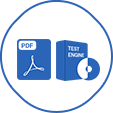The three-way match is a standardized accounts payable process used to verify the legitimacy of a supplier invoice before payment by cross-referencing three key documents: the purchase order (PO), the supplier invoice, and the receiving documents (also referred to as the receiving report, goods received note, or delivery receipt). This process ensures that the invoice reflects the agreed-upon terms of the purchase order and that the goods or services were actually delivered as specified, thereby mitigating risks of overpayment, fraud, or errors.
The correct answer is “Receiving documents,” as these confirm the delivery of goods or services and are a core component of the three-way match. The purchase order authorizes the purchase, specifying quantities, prices, and terms. The invoice details the supplier’s request for payment. The receiving documents verify that the ordered items were delivered, matching the quantities and conditions specified in the PO.
The other options are not part of the three-way match:
Remittance adviceis a document sent to the supplier to confirm payment details after the payment is made, not part of the verification process.
Bank draftis a payment instrument, not a document used for matching.
P-card statementrelates to procurement card transactions, which are typically not subject to the three-way match process, as they follow a different reconciliation process.
The NetSuite source clearly defines the three-way match: “Three-way matching is a payment verification technique that compares the details associated with a particular purchase across a trio of related documents… Purchase order, which authorizes a purchase to be made… Delivery receipt, or a receiving report, which confirms that the purchase was delivered… Supplier’s invoice, which lists how much the buyer owes the supplier”. Similarly, the Tipalti source states: “PO Matching: Ensure accuracy and prevent fraud with 2 and 3-way PO matching,” reinforcing that the three-way match involves the PO, invoice, and receiving documents. The Ramp source further clarifies: “3-way matching is a fraud-prevention process used by accounts payable teams to verify invoices before payment. It cross-checks three documents: Purchase order (PO)… Goods received note (GRN)… Supplier invoice”.
While the IOFM APS study guide is not directly quoted in the provided sources for this specific question, the IOFM Accounts Payable Specialist Certification Program emphasizes the three-way match under the “Invoices” and “Internal Controls” modules. The program description notes that it covers “peer-tested best practices for each phase of the payment process – from receipt of invoice, through processing and payment,” which includes the three-way match process. The focus on accuracy, compliance, and fraud prevention in IOFM’s curriculum aligns with the standard definition of the three-way match involving the PO, invoice, and receiving documents.
[References:, IOFM Accounts Payable Specialist (APS) Certification Program, covering Invoices and Internal Controls, , , , , NetSuite: “Three-way matching is a payment verification technique that compares the details associated with a particular purchase across a trio of related documents”, , , Tipalti: “PO Matching: Ensure accuracy and prevent fraud with 2 and 3-way PO matching”, , , Ramp: “3-way matching is a fraud-prevention process used by accounts payable teams to verify invoices before payment”, , ]

